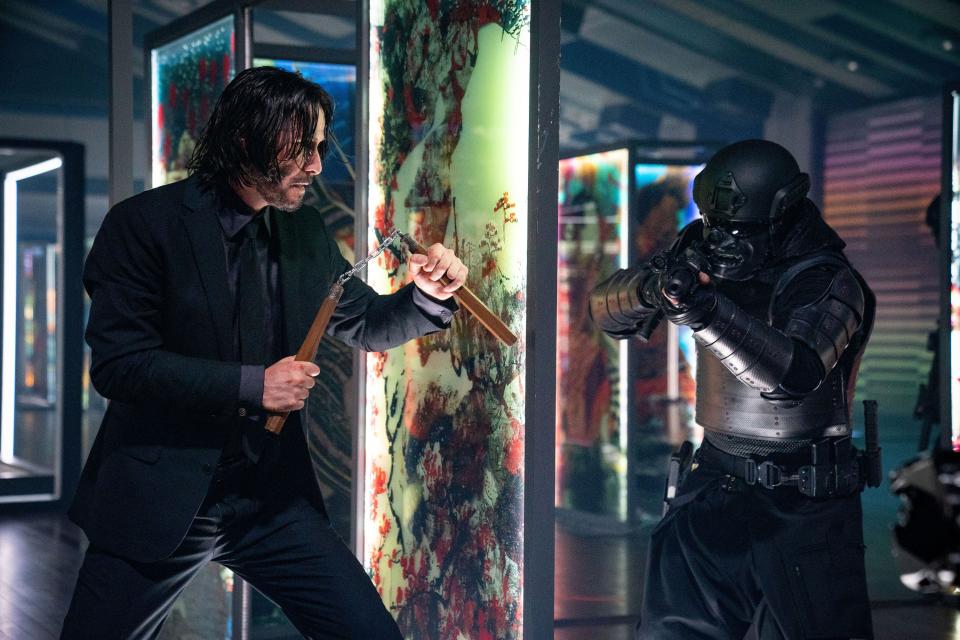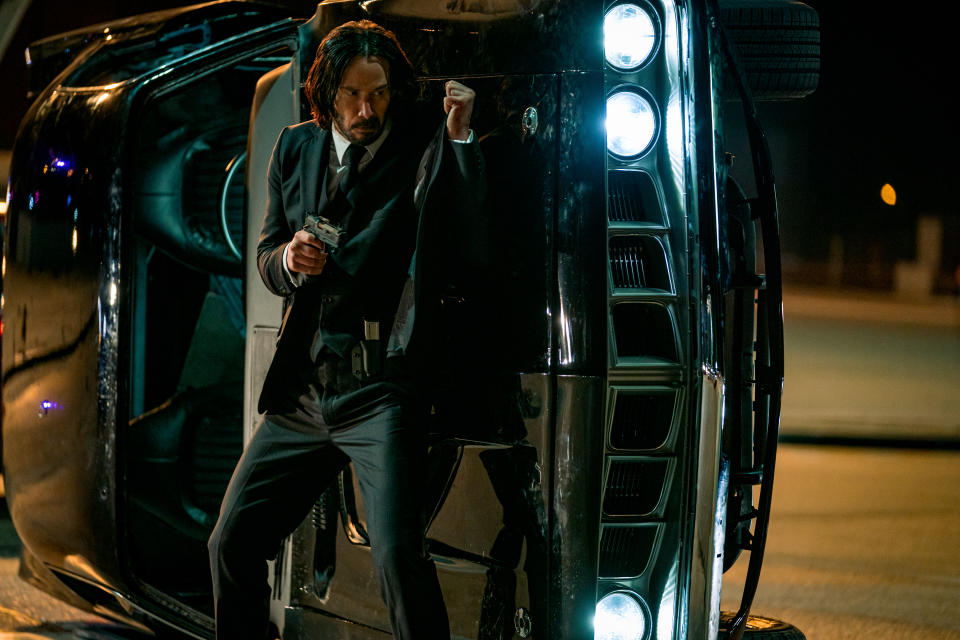Chad Stahelski Is Reinventing How Action Sequences Get Made

- Oops!Something went wrong.Please try again later.
- Oops!Something went wrong.Please try again later.

On December 6, the 2023 IndieWire Honors ceremony will celebrate 11 filmmakers, creators, and actors for their achievements in creative independence. We’re showcasing their work with new interviews leading up to the Los Angeles event.
When Chad Stahelski was working as a stuntman in the 1990s, he had a front-row seat to the way Hollywood typically made action movies — and he didn’t like what he saw. “They’d hire stunt guys and spend a million dollars training the main cast member,” Stahelski told IndieWire. “But then on the day, they’d hire a group of local stunt guys and only give them a day and a half to rehearse. The DP didn’t go to any of the rehearsals, the camera operators wouldn’t see it until they walked on set, and then the guys that had been with the main actor for two months aren’t the guys he fights with. And you wonder why there are so many shitty fight scenes.”
More from IndieWire
Stahelski — who will receive the Maverick Award at the IndieWire Honors on December 6 in Los Angeles — saw a different way of doing things when he was hired to double Keanu Reeves in the original “The Matrix” in 1999. That’s when he got to work with stunt coordinator Yuen Woo-Ping, whose Hong Kong action team took a more integrated approach to fight sequences and followed a model that had as much to do with musicals as action flicks. “They were training the cast in not just martial arts, but martial arts choreography,” Stahelski said. Stahelski became determined to combine what he observed on that set with ideas he had been developing on his own to transform the way filmmakers designed and executed action sequences. “It really came from working with everyone else and seeing how inefficient it was,” he said.
Teaming up with fellow stuntman David Leitch, Stahelski co-founded 87eleven, an action design company that has a dedicated stunt team constantly working to hone their craft and come up with new ways of staging and performing action. “Before ‘The Matrix,’ all stuntmen were independent contractors,” Stahelski said. “There were no real teams.” Stahelski’s team at 87eleven Entertainment (the new company he spun off in 2019 after Leitch left) constantly rehearses anytime they’re not on set. “We have a gym and the team is required to be there five days a week, to learn new martial arts choreography.”

While 87eleven has worked on some of the biggest action franchises of recent years, including the “Hunger Games,” “Bourne,” and “Expendables” series, the fullest fruition of Stahelski’s philosophy of directing action is the series the company developed in-house: John Wick. Stahelski made his directorial debut on the original “John Wick” in 2014 and has helmed each of the series’ sequels, including this year’s “John Wick: Chapter Four,” an action masterpiece that not only invites but earns comparison with some of the greatest genre films of all time.
“John Wick: Chapter Four” is not only Stahelski’s most ambitious and kinetic movie to date, it’s one of the most beautiful action films ever made — a testament to Stahelski’s varied array of influences. He’s as likely to reference foreign art house auteurs like Wong Kar-Wai and Bernardo Bertolucci as he is Hollywood action maestros like Walter Hill and Steven Spielberg, and he’s as big a fan of Gene Kelly and Bob Fosse as he is of “Butch Cassidy and the Sundance Kid” or Sam Peckinpah. In fact, the influence of classic studio musicals on Stahelski’s work is the key to understanding its greatness, as he not only structures his films like musicals — using fight scenes instead of song and dance to express character and move the story forward — but also rehearses them that way.
“We train like dancers,” Stahelski said, noting that while traditional martial arts are antagonistic, his “dance” sequences are all about partnership and combatants making each other look good rather than straightforward dominance. That extends to making the actors look good as well, and Stahelski spends as much time as possible working with leads like Reeves to tailor action to their abilities; part of the greatness of “John Wick: Chapter Four” comes from the fact that Reeves is clearly doing a great deal of his own fighting and stunt driving. The greatness also lies in how expertly designed the dance between the action and the camera is — something Stahelski says is always a struggle, not just artistically but economically.
“It’s so weird to me when a studio will spend a million dollars training a cast member but won’t spend a few thousand dollars to bring in the camera team early,” Stahelski said. “It’s like, ‘Who do you think is shooting the sequence? You’ll pay for the explosions, you’ll pay for the effects, but you won’t pay for the car guys to come in and rehearse in a parking lot?’ This is the methodology that we’re constantly fighting on just about every production.” While Stahelski has found that most productions allot a certain amount of time for prep, shooting, and post regardless of a film’s specific demands, he tends to put more emphasis on pre-production for his movies, and the results speak for themselves — complex sequences like the Arc de Triomphe chase in “John Wick: Chapter Four” are unthinkable without Stahelski’s brand of meticulous planning.

“Rehearsal money is the best money you’ll ever spend,” Stahelski said. Even if he doesn’t plan on presenting a fight as one unbroken take, he choreographs the action that way just to make sure that it flows and that the actor can execute the movement convincingly. “There’s a rhythm to it. We choreograph like it’s music, we work on Keanu’s memory, and that’s the stunt part of it — but that’s not what it takes to get a great action sequence. What that takes is 12 other departments being a part of it.” Keeping that in mind, whenever Stahelski works on another director’s movie as a second unit director he urges the primary director to participate in the rehearsals and previsualization of the action. “I don’t remember a single fight sequence on the ‘Matrix’ movies where the Wachowskis weren’t in the rehearsal hall a few times a week shooting their own pre-viz. If you look at the greatest action or martial arts movies of all time, what they all have in common is involving the entire crew in creating the action sequences. Having the A-list crew do the A-list action. The minute you separate and divide this stuff up, you’re going to get a hacky sequence.”
Stahelski admits that while extensive preparation can save money, his way of doing things can also be more challenging and expensive. “I need the cast members to train,” he said. “If you want ‘The Matrix,’ or ‘John Wick,’ or ‘Bourne,’ then I need a cast that’s committed, and if we’re pulling cast and crew four or five months out, that means they’re not taking other jobs. That means that for some people it’s not financially viable to give you six months of rehearsals. People have lives and they want to make money, and I understand that, but it’s why you see so many average sequences. People don’t understand what it takes. It’s not just about the stunt guys doing cool moves, it’s about putting your cast member in the gym and bringing an all-encompassing mise-en-scène to the action. And it’s not as arduous as I’m making it seem, it’s just a lot of people being on the same page and putting in the prep.”
Even as he rails against Hollywood resisting new and different ways of doing things, Stahelski acknowledges that nothing is set in stone for him either; fine-tuning his approach is what keeps him interested in his work. “We’ve adapted and learned a lot in the last 30 years,” he said. “Our way of making movies was not intuitive, we had to learn it.” One way that Stahelski keeps pushing himself and the “John Wick” franchise is to create obstacles without pre-existing solutions. “I learned it from Jackie Chan: give yourself as many problems as you can. Jackie will handcuff himself to somebody not knowing how to get out of it, and that’s the genius of the choreography because then he comes up with something you’ve never seen before. That’s where the real fun and subversion for the audience comes in — not in the avoidance of problems. It’s how you solve the problem.”
Best of IndieWire
Sign up for Indiewire's Newsletter. For the latest news, follow us on Facebook, Twitter, and Instagram.

